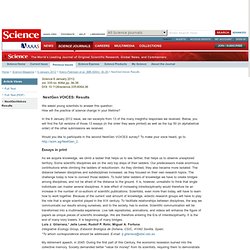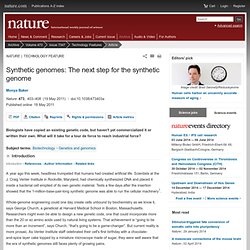

CytoComp reinvents medical treatment - a revolutionary biological computer. Regenesis: How Synthetic Biology Will Reinvent Nature and Ourselves (9780465021758): George M. Church, Ed Regis. Gerd Moe-Behrens - Google+ - Just read this statement by +Eric Schmidt in wired uk… [DIYbio] [Call for Submissions] Biological Systems Design 2012 - BSD-SIG @ ISMB 2012 - July 13, 2012, Long Beach, CA. BioBricks Foundation. The Next DNA Disruptor? Science Comments. Synthetic Biology. NextGenVoices Results. We asked young scientists to answer this question: How will the practice of science change in your lifetime?

In the 6 January 2012 issue, we ran excerpts from 13 of the many insightful responses we received. Below, you will find the full versions of those 13 essays (in the order they were printed) as well as the top 50 (in alphabetical order) of the other submissions we received. Would you like to participate in the second NextGen VOICES survey? To make your voice heard, go to Essays in print As we acquire knowledge, we climb a ladder that helps us to see farther, that helps us to observe unexplored territory. .marketing.lablinks.synthetic. .marketing.lablinks.synthetic. Drop that Pipette: Science by Design. To view the full text, please login as a subscribed user or purchase a subscription.

Click here to view the full text on ScienceDirect. Professors Wendell Lim of UCSF (left) and Dan Fletcher of UC Berkeley (right) dive into “design thinking” during a 1 day workshop at IDEO in Palo Alto. Image courtesy of W. Carey. An unexpected collaboration between a synthetic biology lab at UCSF and a Palo Alto-based design firm is stirring up the way that research is conceived and conducted, by integrating innovation and “design thinking” into the scientific method. Register an Account.
SynBioFromLeukipposInstitute. Synthetic Biology Slam - 2nd Edition. Invalid quantity.

Please enter a quantity of 1 or more. The quantity you chose exceeds the quantity available. Please enter your name. Please enter an email address. Please enter a valid email address. Please enter your message or comments. Please enter the code as shown on the image. Please select the date you would like to attend. Harvard:SysBio 204/2011. Gutmann-Hastings-Essay2011. Synthetic Biology and Organism Engineering. The Chemical Biology Discussion Group brings together chemists and biologists interested in learning about the latest ideas in this rapidly growing field. It provides a forum for lively discussion and for establishing collaborations between chemists armed with novel technologies and biologists receptive to using these approaches to solve their chosen biological problems.
Press DNA2.0 Partners With BioFab. Workshop on Paradigms of Synthetic Biology - 26 to 28 July 2011 at JUIT, solan. Jaypee University of Information Technology (JUIT) and the Joint BioEnergy Institute, Emeryville , CA , USA is jointly organizing a Workshop on “PARADIGMS OF SYNTHETIC BIOLOGY (PSB)” from 26th July to 28th July 2011 .

Workshop Entitled : “PARADIGMS OF SYNTHETIC BIOLOGY (PSB) Main Agenda : his workshop will discuss fundamentals of synthetic biology, emerging standardized and automatable DNA construction methodologies including BioBricks, SLIC, Gibson, CPEC, Golden Gate , USER, yeast DNA assembler, introduction to design concepts and pathway optimization strategies algorithms. The discovery of mathematical logic in gene regulation and early achievements in genetic engineering, such as recombinant DNA technology, paved the way for today’s synthetic biology. Synthetic biology extends the spirit of genetic engineering to focus on whole systems of genes and gene products. Workshop on Paradigms of Synthetic Biology - 26 to 28 July 2011 at JUIT, solan.
Synthetic Biology and Organism Engineering. SB5.0: the Fifth International Meeting on Synthetic Biology. The SynBioLogist. The Synthetic Cell at Age 1 - John Farrell - Progressive Download. Synthetic genomes: The next step for the synthetic genome : Nature. A year ago this week, headlines trumpeted that humans had created artificial life.

Scientists at the J. Craig Venter Institute in Rockville, Maryland, had chemically synthesized DNA and placed it inside a bacterial cell emptied of its own genetic material. Tests a few days after the insertion showed that the 1-million-base-pair-long synthetic genome was able to run the cellular machinery1. Whole-genome engineering could one day create cells unbound by biochemistry as we know it, says George Church, a geneticist at Harvard Medical School in Boston, Massachusetts. Researchers might even be able to design a new genetic code, one that could incorporate more than the 20 or so amino acids used by natural living systems. Strains of Escherichia coli have been developed to produce lycopene, an antioxidant found in tomatoes.
Breathless headlines notwithstanding, the Venter Institute team did not create life so much as copy an existing plan. Learning to write genomes. Nature_synthetic_genome. Synthetic Cells. Designing new genomes could speed the creation of vaccines and biofuel-producing bacteria 1: Bacterial genomes take the form of rings of DNA.

An artificial genome is designed on a computer, including a sequence that “watermarks” the genome (red arc) and one that confers resistance to antibiotics (yellow arc). The genome is then synthesized as 1,078 overlapping DNA fragments. 2: Yeast cells stitch together 10 sequential fragments at a time. The longer strands that are produced are in turn stitched together by other yeast cells, and the process is repeated until copies of the whole genome are assembled. 3: The synthetic genomes are added to a colony of bacteria. Some of the bacterial cells entering the process of division absorb the synthetic genomes alongside their own. 4: When the bacterial cells divide, each daughter inherits one genome.
Synthetic_genomes. Boston University » College of Engineering » In the News » Mobilizing Microbes. BU-Led Team to Engineer Robot-Assisted, Bacteria-Based Sensors By Mark Dwortzan ENG research will support the project's three main thrusts: programmed bacteria with engineered biomolecular sensors and synthetic gene networks, two-way communication between micro-bio-robots (MBRs) and chaperone robots, and swarms of MBRs supervised by chaperone robot systems.

At the bottom level, engineered bacteria interact among each other mechanically (through the surface they adhere to) and chemically (through diffusion). At the middle level, MBRs communicate among themselves and with the chaperone robots locally via light or chemical inducers. At the top level, the chaperone robots communicate among themselves and with a supervisor through wireless communication.
Now a research team led by Professor James Collins (BME, MSE, SE) proposes to surmount these challenges through an unprecedented combination of expertise in synthetic biology, computer engineering, control systems and robotics. Harvard_designing.